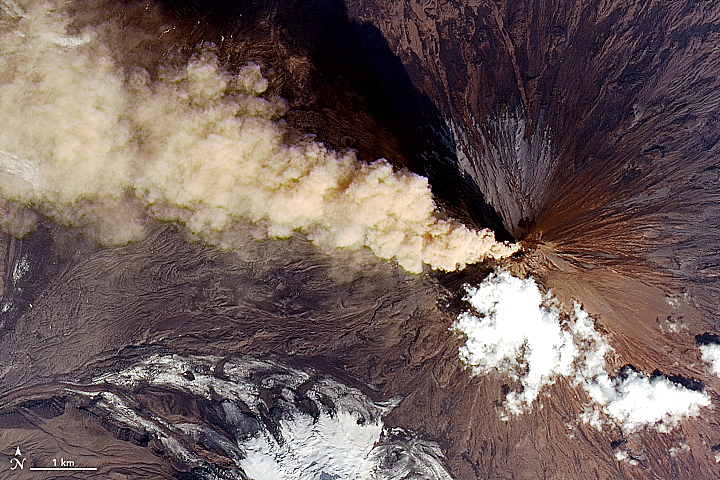Monitoring the Environment from Space
Klyuchevskoi Volcano, Kamchatka Peninsula, Russia 8-20-2017 (credit: NASA Terra/JPL)
Satellites are perfect tools for making environmental observations. They can track developing storms for weather predictions; provide information on illegal fishing vessels; monitor environmental changes due to climate change; and they can observe volcanic eruptions to alert airlines. A perfect example of this latter use is an of a massive eruption in the Siberian region of Kamchatka.
According to the Jet Propulsion Laboratory in Pasadena, the Klyuchevskoi volcano is one of the world's most active and was observed during a major eruption. The volcanic cone rises nearly 16,000 feet in elevation and was scanned using infrared sensors on NASA's Terra Earth monitoring satellite. The peak is seen poking through a thick cloud cover with fine ash streaming high into the atmosphere. Klyuchevoskoi is in the Russian 'far east' and one of many volcanoes on the peninsula. Kamchatka is part of the Pacific 'ring of fire' stretching from the Aleutian Islands in Alaska across to Japan and down to Indonesia.

Ash Plume Klyuchevskoi Volcano Erupting on Kamchatka Peninsula, 8-19-2017 (credit: NASA)
The cameras on Terra include the Advanced Spaceborne Thermal Emissions & Reflection Radiometer, ASTER. The light wavelengths that can be scanned and high resolution of the imagery offers investigators across many scientific fields. The photography offers vital information for Earth surface mapping, monitoring environmental conditions, and the dynamic geogrpahic changes over time. Remote sensing applications have included tracking glacial advances and retreats; watching active eruptions like Klyuchevskoi; identifying crop stress from pests and diseases using infrared light; wetlands and deforestation monitoring; pollution observations; and coral reef degradation are just a few examples.
Any passenger on a flight to Japan, China, or Southeast Asia, across this wide volcanic region, might not be aware of Terra's environmental sensors but their constant observation of potential volcanic ash plumes that can destroy jet engines would surely be appreciated.
WHB